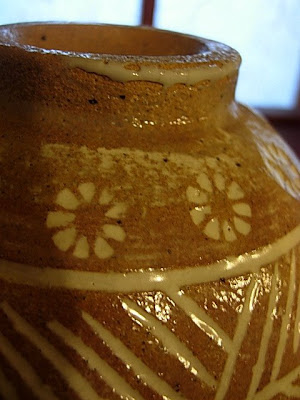


This style of tea drinking bowl can be traced back to June 6th, 1565 where it is described in written records by the Japanese. The name ‘Sam Do’ or ‘Three Islands’ refers to the three islands in the south of Korea where the Japanese first stumbled across this style. It most likely erroneously alludes to two islands and part of the peninsula which was mistaken as being completely surrounded by water.
These bowls are marked with white. Most, but not all, have short slashes of white just inside and/or outside the lip of the bowl. These dashes give the bowls a feeling of movement and depth. At the bottom of these bowls there is a rather short simple, even cut ‘Haes Moo Ri’ style foot. These pieces are often heavily glazed.
These bowls are marked with white. Most, but not all, have short slashes of white just inside and/or outside the lip of the bowl. These dashes give the bowls a feeling of movement and depth. At the bottom of these bowls there is a rather short simple, even cut ‘Haes Moo Ri’ style foot. These pieces are often heavily glazed.

There are many subclasses of ‘Sam Do’ bowls the most popular and probably most spectacular being the ‘Hwa Sam Do’. ‘Hwa’ means flower so these bowls are ‘Flowered Three Island’ Bowls. They carry this name because there are white flowers that are stamped onto the bowl using a stone or wood carved stamp. Quite often there are thousands of these little white flowers that cover the inside and sometimes the outside of these bowls creating a wonderful blossoming effect.
These bowls, like many others from this early time, were coveted by the Japanese. Today, however this style is not in vogue, and is quite a rarer sight.

This bowl is a different subtype of the sam do style- 'Ju Sam Do'. All 'Ju Sam Do' bowls, from a far distance , look completely identical. Only upon close inspection can you notice the subtleties that divide amateur 'Ju Sam Do' bowls from the 'Ju Sam Do' bowls of masters.
This wonderful example of the ‘Ju Sam Do’ style is by buncheong master Kim Jeong Oak. This piece looks quite respectable in shape and form. When cupped in the palms of the hands this bowl feels wild and uncut as flesh senses the criss-crossing white divots.

The flowers are not overdone in this piece and linger near the bottom. They serve to balance and give elegance to the many white slashes that hover above. The cloudy glaze around the foot of this bowl hints at its genius, a last attempt at turning simple and wild into soft stable sophisticated beauty. You can feel the movement and balance in this bowl from top to bottom, from rough to refined.
Doesn’t our restless mind also follow this progression after taking time in our busy days to drink tea?
Surely drinking matcha from this bowl would bring about such an affect.
Peace

No comments:
Post a Comment